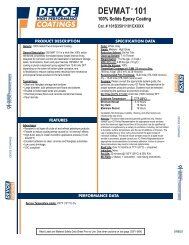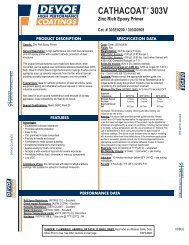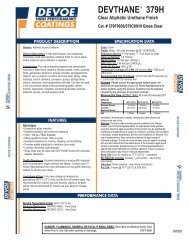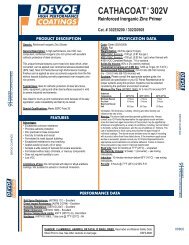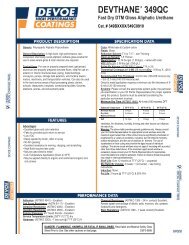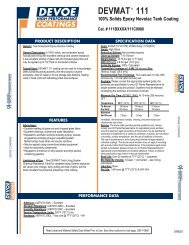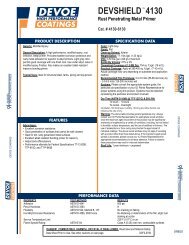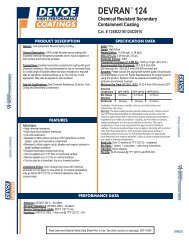Material Safety Data Sheet
Material Safety Data Sheet
Material Safety Data Sheet
You also want an ePaper? Increase the reach of your titles
YUMPU automatically turns print PDFs into web optimized ePapers that Google loves.
<strong>Material</strong> <strong>Safety</strong> <strong>Data</strong> <strong>Sheet</strong><br />
Date of issue 16 September 2012<br />
Version 20<br />
1 .<br />
Product name<br />
Code<br />
Supplier<br />
Product and company identification<br />
Emergency telephone<br />
number<br />
: WHITE BASE 2.8 VOC PITTHANE<br />
:<br />
:<br />
:<br />
95-8001<br />
PPG Industries, Inc.<br />
One PPG Place<br />
Pittsburgh, PA 15272<br />
(412) 434-4515 (U.S.)<br />
(514) 645-1320 (Canada)<br />
01-800-00-21-400 (Mexico)<br />
Technical Phone Number : 888-977-4762<br />
2 .<br />
Hazards identification<br />
Emergency overview<br />
Potential acute health effects<br />
Inhalation<br />
Ingestion<br />
Skin<br />
Eyes<br />
Medical conditions<br />
aggravated by overexposure<br />
WARNING!<br />
See toxicological information (Section 11)<br />
:<br />
: May be harmful if inhaled. Irritating to respiratory system. Can irritate eyes, nose,<br />
mouth and throat.<br />
: May be harmful if swallowed.<br />
:<br />
:<br />
Over-exposure signs/symptoms<br />
Repeated exposure to high vapor concentrations may cause irritation of the respiratory system and permanent brain and<br />
nervous system damage. Inhalation of vapor/aerosol concentrations above the recommended exposure limits causes<br />
headaches, drowsiness and nausea and may lead to unconsciousness or death. There is some evidence that repeated<br />
exposure to organic solvent vapors in combination with constant loud noise can cause greater hearing loss than expected<br />
from exposure to noise alone.<br />
:<br />
FLAMMABLE LIQUID AND VAPOR. CAUSES RESPIRATORY TRACT IRRITATION.<br />
MAY BE HARMFUL IF INHALED OR SWALLOWED. SANDING AND GRINDING<br />
DUSTS MAY BE HARMFUL IF INHALED. MAY CAUSE EYE IRRITATION.<br />
PROLONGED OR REPEATED CONTACT MAY DRY SKIN AND CAUSE IRRITATION.<br />
CONTAINS MATERIAL THAT CAN CAUSE TARGET ORGAN DAMAGE.<br />
Keep away from flames, such as a pilot light, and any object that sparks, such as an<br />
electric motor. Keep away from heat. Do not smoke. Do not swallow. Avoid breathing<br />
vapor or mist. Avoid contact with eyes, skin and clothing. Use only with adequate<br />
ventilation. Keep container tightly closed and sealed until ready for use. Wash<br />
thoroughly after handling.<br />
May cause skin dryness and irritation.<br />
Moderately irritating to eyes.<br />
Pre-existing disorders involving any target organs mentioned in this MSDS as being at<br />
risk may be aggravated by over-exposure to this product.<br />
This <strong>Material</strong> <strong>Safety</strong> <strong>Data</strong> <strong>Sheet</strong> has been prepared in accordance with Canada's Workplace Hazardous <strong>Material</strong>s<br />
Information System (WHMIS) and the OSHA Hazard Communication Standard (29 CFR 1910.1200).<br />
United States - Canada - Mexico<br />
Page: 1/8
Product code 95-8001 Date of issue 16 September 2012Version<br />
Product name WHITE BASE 2.8 VOC PITTHANE<br />
3 .<br />
Composition/information on ingredients<br />
Name CAS number %<br />
titanium dioxide 13463-67-7 10 - 30<br />
heptan-2-one 110-43-0 10 - 30<br />
barium sulfate 7727-43-7 7 - 13<br />
silicon dioxide 7631-86-9 1 - 5<br />
xylene 1330-20-7 0.1 - 1<br />
methyl methacrylate 80-62-6 0.1 - 1<br />
There are no additional ingredients present which, within the current knowledge of the supplier and in the<br />
concentrations applicable, are classified as hazardous to health or the environment and hence require reporting<br />
in this section.<br />
4 .<br />
Eye contact<br />
Skin contact<br />
Inhalation<br />
Ingestion<br />
First aid measures<br />
If ingestion, irritation, any type of overexposure or symptoms of overexposure occur during or persists after use of this<br />
product, contact a POISON CONTROL CENTER, EMERGENCY ROOM OR PHYSICIAN immediately; have <strong>Material</strong><br />
<strong>Safety</strong> <strong>Data</strong> <strong>Sheet</strong> information available. Never give anything by mouth to an unconscious or convulsing person.<br />
Notes to physician<br />
5 .<br />
Fire-fighting measures<br />
Flammability of the product :<br />
Extinguishing media<br />
Suitable :<br />
Not suitable :<br />
Special exposure hazards :<br />
Hazardous combustion<br />
products<br />
Special protective<br />
equipment for fire-fighters<br />
:<br />
:<br />
:<br />
:<br />
:<br />
:<br />
Check for and remove any contact lenses. Immediately flush eyes with running<br />
water for at least 15 minutes, keeping eyelids open. Seek immediate medical<br />
attention.<br />
Remove contaminated clothing and shoes. Wash skin thoroughly with soap and<br />
water or use recognized skin cleanser. Do NOT use solvents or thinners.<br />
Remove to fresh air. Keep person warm and at rest. If not breathing, if breathing is<br />
irregular or if respiratory arrest occurs, provide artificial respiration or oxygen by<br />
trained personnel.<br />
If swallowed, seek medical advice immediately and show this container or label.<br />
Keep person warm and at rest. Do NOT induce vomiting.<br />
No specific treatment. Treat symptomatically. Contact poison treatment specialist<br />
immediately if large quantities have been ingested or inhaled.<br />
Flammable liquid. In a fire or if heated, a pressure increase will occur and the container<br />
may burst, with the risk of a subsequent explosion. Vapors may accumulate in low or<br />
confined areas or travel a considerable distance to a source of ignition and flash back.<br />
Runoff to sewer may create fire or explosion hazard.<br />
Use dry chemical, CO₂, water spray (fog) or foam.<br />
Do not use water jet.<br />
Promptly isolate the scene by removing all persons from the vicinity of the incident if<br />
there is a fire. No action shall be taken involving any personal risk or without suitable<br />
training. Move containers from fire area if this can be done without risk. Use water<br />
spray to keep fire-exposed containers cool.<br />
: Decomposition products may include the following materials:<br />
carbon oxides<br />
sulfur oxides<br />
metal oxide/oxides<br />
Fire-fighters should wear appropriate protective equipment and self-contained breathing<br />
apparatus (SCBA) with a full face-piece operated in positive pressure mode.<br />
20<br />
United States - Canada - Mexico<br />
Page: 2/8
Product code 95-8001 Date of issue 16 September 2012Version<br />
Product name WHITE BASE 2.8 VOC PITTHANE<br />
6 .<br />
Accidental release measures<br />
Personal precautions : No action shall be taken involving any personal risk or without suitable training.<br />
Evacuate surrounding areas. Keep unnecessary and unprotected personnel from<br />
entering. Do not touch or walk through spilled material. Shut off all ignition sources. No<br />
flares, smoking or flames in hazard area. Avoid breathing vapor or mist. Provide<br />
adequate ventilation. Wear appropriate respirator when ventilation is inadequate. Put<br />
on appropriate personal protective equipment (see Section 8).<br />
Environmental precautions : Avoid dispersal of spilled material and runoff and contact with soil, waterways, drains<br />
and sewers. Inform the relevant authorities if the product has caused environmental<br />
Large spill :<br />
Small spill :<br />
7 .<br />
Handling<br />
Storage<br />
8 .<br />
Handling and storage<br />
:<br />
:<br />
pollution (sewers, waterways, soil or air).<br />
Stop leak if without risk. Move containers from spill area. Approach release from<br />
upwind. Use spark-proof tools and explosion-proof equipment. Prevent entry into<br />
sewers, water courses, basements or confined areas. Wash spillages into an effluent<br />
treatment plant or proceed as follows. Contain and collect spillage with non-combustible,<br />
absorbent material e.g. sand, earth, vermiculite or diatomaceous earth and place in<br />
container for disposal according to local regulations (see Section 13). Dispose of via a<br />
licensed waste disposal contractor. Contaminated absorbent material may pose the<br />
same hazard as the spilled product. Note: see Section 1 for emergency contact<br />
information and Section 13 for waste disposal.<br />
Stop leak if without risk. Move containers from spill area. Use spark-proof tools and<br />
explosion-proof equipment. Dilute with water and mop up if water-soluble or absorb with<br />
an inert dry material and place in an appropriate waste disposal container. Dispose of<br />
via a licensed waste disposal contractor.<br />
Put on appropriate personal protective equipment (see Section 8). Eating, drinking and<br />
smoking should be prohibited in areas where this material is handled, stored and<br />
processed. Do not swallow. Do not get in eyes or on skin or clothing. Avoid breathing<br />
vapor or mist. Use only with adequate ventilation. Wear appropriate respirator when<br />
ventilation is inadequate. Do not enter storage areas and confined spaces unless<br />
adequately ventilated. Keep in the original container or an approved alternative made<br />
from a compatible material, kept tightly closed when not in use. Store and use away<br />
from heat, sparks, open flame or any other ignition source. Use explosion-proof<br />
electrical (ventilating, lighting and material handling) equipment. Use non-sparking tools.<br />
Take precautionary measures against electrostatic discharges. Vapors are heavier than<br />
air and may spread along floors. To avoid fire or explosion, dissipate static electricity<br />
during transfer by grounding and bonding containers and equipment before transferring<br />
material. Empty containers retain product residue and can be hazardous. Do not reuse<br />
container. If this material is part of a multiple component system, read the <strong>Material</strong><br />
<strong>Safety</strong> <strong>Data</strong> <strong>Sheet</strong>(s) for the other component or components before blending as the<br />
resulting mixture may have the hazards of all of its parts.<br />
Store in accordance with local regulations. Store in a segregated and approved area.<br />
Store in original container protected from direct sunlight in a dry, cool and well-ventilated<br />
area, away from incompatible materials (see Section 10) and food and drink. Eliminate<br />
all ignition sources. Separate from oxidizing materials. Keep container tightly closed<br />
and sealed until ready for use. Containers that have been opened must be carefully<br />
resealed and kept upright to prevent leakage. Do not store in unlabeled containers.<br />
Use appropriate containment to avoid environmental contamination. Do not store above<br />
the following temperature: 120F / 49C.<br />
Exposure controls/personal protection<br />
Name Result ACGIH OSHA Ontario Mexico PPG<br />
20<br />
United States - Canada - Mexico<br />
Page: 3/8
Product code 95-8001 Date of issue 16 September 2012Version<br />
Product name WHITE BASE 2.8 VOC PITTHANE<br />
8 .<br />
Exposure controls/personal protection<br />
titanium dioxide TWA 10 mg/m³ 15 mg/m³ TD 10 mg/m³ TD 10 mg/m³<br />
(as Ti)<br />
Not<br />
established<br />
STEL Not<br />
established<br />
Not<br />
established<br />
Not<br />
established<br />
20 mg/m³<br />
(as Ti)<br />
Not<br />
established<br />
____________________________ ___________ ___________ ___________ ___________ ___________ ___________<br />
heptan-2-one TWA 50 ppm 100 ppm 25 ppm 50 ppm Not<br />
established<br />
STEL Not<br />
established<br />
Not<br />
established<br />
Not<br />
established<br />
100 ppm Not<br />
established<br />
____________________________ ___________ ___________ ___________ ___________ ___________ ___________<br />
barium sulfate TWA 10 mg/m³ 5 mg/m³ R<br />
15 mg/m³ TD<br />
10 mg/m³ TD Not<br />
established<br />
Not<br />
established<br />
____________________________ ___________ ___________ ___________ ___________ ___________ ___________<br />
silicon dioxide TWA Not<br />
established<br />
Not<br />
established<br />
Not<br />
established<br />
10 mg/m³<br />
3 mg/m³ R<br />
Not<br />
established<br />
____________________________ ___________ ___________ ___________ ___________ ___________ ___________<br />
xylene TWA 100 ppm 100 ppm 100 ppm 100 ppm Not<br />
established<br />
STEL 150 ppm Not<br />
established<br />
150 ppm 150 ppm Not<br />
established<br />
____________________________ ___________ ___________ ___________ ___________ ___________ ___________<br />
methyl methacrylate TWA 50 ppm SS 100 ppm 50 ppm SS 100 ppm Not<br />
established<br />
STEL 100 ppm SS Not<br />
established<br />
100 ppm SS 125 ppm Not<br />
established<br />
____________________________ ___________ ___________ ___________ ___________ ___________ ___________<br />
Key to abbreviations<br />
A = Acceptable Maximum Peak<br />
ACGIH = American Conference of Governmental Industrial Hygienists.<br />
C = Ceiling Limit<br />
F = Fume<br />
IPEL = Internal Permissible Exposure Limit<br />
OSHA = Occupational <strong>Safety</strong> and Health Administration.<br />
R = Respirable<br />
Z = OSHA 29CFR 1910.1200 Subpart Z - Toxic and Hazardous Substances<br />
Consult local authorities for acceptable exposure limits.<br />
Recommended monitoring<br />
procedures<br />
Engineering measures<br />
Hygiene measures<br />
Personal protection<br />
Eyes<br />
Hands<br />
S = Potential skin absorption<br />
SR = Respiratory sensitization<br />
SS = Skin sensitization<br />
STEL = Short term Exposure limit values<br />
TD = Total dust<br />
TLV = Threshold Limit Value<br />
TWA = Time Weighted Average<br />
: If this product contains ingredients with exposure limits, personal, workplace<br />
atmosphere or biological monitoring may be required to determine the effectiveness of<br />
the ventilation or other control measures and/or the necessity to use respiratory<br />
protective equipment. Reference should be made to appropriate monitoring standards.<br />
Reference to national guidance documents for methods for the determination of<br />
hazardous substances will also be required.<br />
: Use only with adequate ventilation. Use process enclosures, local exhaust ventilation or<br />
other engineering controls to keep worker exposure to airborne contaminants below any<br />
recommended or statutory limits. The engineering controls also need to keep gas,<br />
vapor or dust concentrations below any lower explosive limits. Use explosion-proof<br />
ventilation equipment.<br />
: Wash hands, forearms and face thoroughly after handling chemical products, before<br />
eating, smoking and using the lavatory and at the end of the working period.<br />
Appropriate techniques should be used to remove potentially contaminated clothing.<br />
Wash contaminated clothing before reusing. Ensure that eyewash stations and safety<br />
showers are close to the workstation location.<br />
: <strong>Safety</strong> glasses with side shields.<br />
: Chemical-resistant, impervious gloves complying with an approved standard should be<br />
worn at all times when handling chemical products if a risk assessment indicates this is<br />
necessary. Considering the parameters specified by the glove manufacturer, check<br />
during use that the gloves are still retaining their protective properties. It should be<br />
noted that the time to breakthrough for any glove material may be different for different<br />
glove manufacturers. In the case of mixtures, consisting of several substances, the<br />
protection time of the gloves cannot be accurately estimated.<br />
20<br />
United States - Canada - Mexico<br />
Page: 4/8
Product code 95-8001 Date of issue 16 September 2012Version<br />
Product name WHITE BASE 2.8 VOC PITTHANE<br />
8 .<br />
Skin<br />
Exposure controls/personal protection<br />
Respiratory<br />
Environmental exposure<br />
controls<br />
9 .<br />
Physical state<br />
Flash point<br />
Odor<br />
pH<br />
Boiling/condensation point<br />
Melting/freezing point<br />
: If workers are exposed to concentrations above the exposure limit, they must use<br />
appropriate, certified respirators. Use a properly fitted, air-purifying or air-fed respirator<br />
complying with an approved standard if a risk assessment indicates this is necessary.<br />
Respirator selection must be based on known or anticipated exposure levels, the<br />
hazards of the product and the safe working limits of the selected respirator.<br />
: Personal protective equipment for the body should be selected based on the task being<br />
performed and the risks involved and should be approved by a specialist before<br />
handling this product.<br />
When there is a risk of ignition from static electricity, wear anti-static protective clothing.<br />
For the greatest protection from static discharges, clothing should include anti-static<br />
overalls, boots and gloves.<br />
: Emissions from ventilation or work process equipment should be checked to ensure<br />
they comply with the requirements of environmental protection legislation. In some<br />
cases, fume scrubbers, filters or engineering modifications to the process equipment will<br />
be necessary to reduce emissions to acceptable levels.<br />
Physical and chemical properties<br />
Specific gravity<br />
: Liquid.<br />
: Closed cup: 28.89°C (84°F)<br />
Explosion limits : Lower: 1.2%<br />
<strong>Material</strong> supports<br />
: Yes.<br />
combustion.<br />
Color<br />
: Not available.<br />
Not available.<br />
Not available.<br />
>37.78°C (>100°F)<br />
Not available.<br />
1.48<br />
Density ( lbs / gal ) : 12.35<br />
Vapor pressure<br />
: 0.32 kPa (2.4 mm Hg) [room temperature]<br />
Vapor density<br />
Volatility<br />
Evaporation rate<br />
:<br />
:<br />
:<br />
:<br />
:<br />
:<br />
:<br />
:<br />
Not available.<br />
37% (v/v), 20.4% (w/w)<br />
0.41 (butyl acetate = 1)<br />
Partition coefficient: n- : Not available.<br />
octanol/water<br />
% Solid. (w/w) : 79.6<br />
20<br />
10 .<br />
Stability and reactivity<br />
Stability<br />
Conditions to avoid<br />
<strong>Material</strong>s to avoid<br />
Hazardous decomposition<br />
products<br />
Hazardous polymerization<br />
: Stable under recommended storage and handling conditions (see Section 7).<br />
: Avoid all possible sources of ignition (spark or flame). Do not pressurize, cut, weld,<br />
braze, solder, drill, grind or expose containers to heat or sources of ignition.<br />
: Reactive or incompatible with the following materials:,acids,oxidizing materials,strong<br />
alkalis<br />
: Under normal conditions of storage and use, hazardous decomposition products should<br />
not be produced.<br />
: Under normal conditions of storage and use, hazardous polymerization will not occur.<br />
United States - Canada - Mexico<br />
Page: 5/8
Product code 95-8001 Date of issue 16 September 2012Version<br />
Product name WHITE BASE 2.8 VOC PITTHANE<br />
11 . Toxicological information<br />
20<br />
Acute toxicity<br />
Product/ingredient name Result Species Dose Exposure<br />
titanium dioxide LD50 Oral Rat >10 g/kg -<br />
heptan-2-one LD50 Oral Rat 1.6 g/kg -<br />
LD50 Dermal Rabbit 10.206 g/kg -<br />
xylene LD50 Oral Rat 4.3 g/kg -<br />
LD50 Dermal Rabbit >1.7 g/kg -<br />
LC50 Inhalation Rat 5000 ppm 4 hours<br />
Vapor<br />
methyl methacrylate LD50 Oral Rat 7872 mg/kg -<br />
LD50 Dermal Rabbit >5 g/kg -<br />
LC50 Inhalation<br />
Vapor<br />
Rat 78000 mg/m3 4 hours<br />
Conclusion/Summary<br />
Chronic toxicity<br />
Conclusion/Summary<br />
Defatting irritant<br />
Target organs<br />
Carcinogenicity<br />
Carcinogenicity<br />
Classification<br />
Carcinogen Classification code:<br />
Teratogenicity<br />
: Not available.<br />
: Not available.<br />
: Prolonged or repeated contact can defat the skin and lead to irritation, cracking and/or<br />
dermatitis.<br />
: Contains material which causes damage to the following organs: brain.<br />
Contains material which may cause damage to the following organs: lungs, peripheral<br />
nervous system, upper respiratory tract, skin, central nervous system (CNS), eye, lens<br />
or cornea, nose/sinuses, throat.<br />
: Contains material which may cause cancer, based on animal data. Risk of cancer<br />
depends on duration and level of exposure.<br />
Product/ingredient name<br />
ACGIH IARC<br />
NTP OSHA<br />
titanium dioxide A4 2B - -<br />
silicon dioxide - 3 - -<br />
methyl methacrylate A4 3 - -<br />
12 .<br />
Ecological information<br />
Environmental effects<br />
Aquatic ecotoxicity<br />
ACGIH: A1, A2, A3, A4, A5<br />
IARC: 1, 2A, 2B, 3, 4<br />
NTP: Proven, Possible<br />
OSHA: +<br />
Not listed or regulated as a carcinogen: -<br />
: Contains material which may cause birth defects, based on animal data.<br />
: No known significant effects or critical hazards.<br />
Product/ingredient<br />
name<br />
Result<br />
Species<br />
Exposure<br />
heptan-2-one<br />
Acute LC50 131000 to 137000 ug/L Fish - Fathead minnow - Pimephales 96 hours<br />
Fresh water<br />
promelas<br />
______________________ _________________________________ ________________________________ __________<br />
barium sulfate Acute EC50 32000 ug/L Fresh water Daphnia - Water flea - Daphnia magna 48 hours<br />
______________________ _________________________________ ________________________________ __________<br />
xylene<br />
Acute LC50 3300 to 4093 ug/L Fresh Fish - Rainbow trout,donaldson trout - 96 hours<br />
water<br />
Oncorhynchus mykiss<br />
______________________ _________________________________ ________________________________ __________<br />
methyl methacrylate Acute LC50 130000 ug/L Fresh water Fish - Fathead minnow - Pimephales 96 hours<br />
promelas<br />
______________________ _________________________________ ________________________________ __________<br />
United States - Canada - Mexico<br />
Page: 6/8
Product code 95-8001 Date of issue 16 September 2012Version<br />
Product name WHITE BASE 2.8 VOC PITTHANE<br />
13 .<br />
Disposal considerations<br />
Waste disposal<br />
:<br />
The generation of waste should be avoided or minimized wherever possible. Disposal<br />
of this product, solutions and any by-products should at all times comply with the<br />
requirements of environmental protection and waste disposal legislation and any<br />
regional local authority requirements. Dispose of surplus and non-recyclable products<br />
via a licensed waste disposal contractor. Waste should not be disposed of untreated to<br />
the sewer unless fully compliant with the requirements of all authorities with jurisdiction.<br />
Waste packaging should be recycled. Incineration or landfill should only be considered<br />
when recycling is not feasible. This material and its container must be disposed of in a<br />
safe way. Care should be taken when handling emptied containers that have not been<br />
cleaned or rinsed out. Empty containers or liners may retain some product residues.<br />
Vapor from product residues may create a highly flammable or explosive atmosphere<br />
inside the container. Do not cut, weld or grind used containers unless they have been<br />
cleaned thoroughly internally. Avoid dispersal of spilled material and runoff and contact<br />
with soil, waterways, drains and sewers.<br />
Disposal should be in accordance with applicable regional, national and local laws and regulations.<br />
Refer to Section 7: HANDLING AND STORAGE and Section 8: EXPOSURE CONTROLS/PERSONAL PROTECTION<br />
for additional handling information and protection of employees. Section 6. Accidental release measures<br />
14 .<br />
Transport information<br />
Regulation UN number Proper shipping name Classes PG*<br />
UN 1263 PAINT 3 III<br />
IMDG 1263 PAINT 3 III -<br />
20<br />
Additional information<br />
-<br />
DOT<br />
1263 PAINT<br />
3<br />
III<br />
Reportable quantity<br />
40174.5 lbs / 18239.2 kg<br />
[3249.1 gal / 12299.1 L]<br />
Package sizes shipped in<br />
quantities less than the<br />
product reportable quantity<br />
are not subject to the RQ<br />
(reportable quantity)<br />
transportation requirements.<br />
PG* : Packing group<br />
Reportable quantity RQ :<br />
15 . Regulatory information<br />
United States inventory (TSCA 8b) :<br />
Australia inventory (AICS)<br />
Canada inventory ( DSL ) :<br />
China inventory (IECSC) :<br />
Europe inventory ( REACH )<br />
Japan inventory (ENCS) :<br />
Korea inventory (KECI) :<br />
New Zealand ( NZIoC )<br />
Philippines inventory (PICCS) :<br />
United States<br />
CERCLA: Hazardous substances.: xylene: 100 lbs. (45.4 kg); methyl methacrylate: 1000 lbs.<br />
(454 kg);<br />
:<br />
:<br />
All components are listed or exempted.<br />
At least one component is not listed.<br />
All components are listed or exempted.<br />
All components are listed or exempted.<br />
: Please contact your supplier for information on the inventory status of this material.<br />
Not determined.<br />
All components are listed or exempted.<br />
Substance Use Restricted<br />
All components are listed or exempted.<br />
U.S. Federal regulations :<br />
SARA 302/304/311/312 extremely hazardous substances: No products were found.<br />
SARA 302/304 emergency planning and notification: No products were found.<br />
SARA 302/304/311/312 hazardous chemicals: barium sulfate; heptan-2-one; titanium dioxide<br />
CERCLA: Hazardous substances.: xylene: 100 lbs. (45.4 kg); methyl methacrylate: 1000 lbs. (454 kg);<br />
United States - Canada - Mexico<br />
Page: 7/8
Product code 95-8001 Date of issue 16 September 2012Version<br />
Product name WHITE BASE 2.8 VOC PITTHANE<br />
15 . Regulatory information<br />
SARA 311/312 MSDS Distribution - Chemical Inventory - Hazard Identification:<br />
Chemical name CAS # Acute Chronic Fire Reactive Pressure<br />
titanium dioxide 13463-67-7 N Y N N N<br />
heptan-2-one 110-43-0 Y N Y N N<br />
barium sulfate 7727-43-7 N N N N N<br />
silicon dioxide 7631-86-9 N N N N N<br />
methyl methacrylate 80-62-6 Y Y Y Y N<br />
Product as-supplied : Y Y Y N N<br />
Additional environmental information is contained on the Environmental <strong>Data</strong> <strong>Sheet</strong> for this product, which can<br />
be obtained from your PPG representative.<br />
Canada<br />
WHMIS (Canada)<br />
Mexico<br />
Classification<br />
Flammability<br />
16 .<br />
:<br />
Class B-2: Flammable liquid with a flash point lower than 37.8°C (100°F). Class D-2A:<br />
<strong>Material</strong> causing other toxic effects (Very toxic). Class D-2B: <strong>Material</strong> causing other<br />
toxic effects (Toxic).<br />
: 3 Health : 2 Reactivity : 0<br />
Other information<br />
Hazardous <strong>Material</strong> Information System (U.S.A.)<br />
Health : 2 * Flammability : 3 Physical hazards :<br />
( * ) - Chronic<br />
effects<br />
Caution: HMIS® ratings are based on a 0-4 rating scale, with 0 representing minimal hazards or risks, and 4<br />
representing significant hazards or risks Although HMIS® ratings are not required on MSDSs under 29 CFR 1910.<br />
1200, the preparer may choose to provide them. HMIS® ratings are to be used with a fully implemented HMIS®<br />
program. HMIS® is a registered mark of the National Paint & Coatings Association (NPCA). HMIS® materials may<br />
be purchased exclusively from J. J. Keller (800) 327-6868.<br />
The customer is responsible for determining the PPE code for this material.<br />
National Fire Protection Association (U.S.A.)<br />
Health<br />
Disclaimer<br />
: 2 Flammability : 3 Instability :<br />
Date of previous issue : 6/30/2012.<br />
Organization that prepared<br />
the MSDS<br />
: EHS<br />
Indicates information that has changed from previously issued version.<br />
The information contained in this data sheet is based on present scientific and technical knowledge. The purpose of this<br />
information is to draw attention to the health and safety aspects concerning the products supplied by PPG, and to<br />
recommend precautionary measures for the storage and handling of the products. No warranty or guarantee is given in<br />
respect of the properties of the products. No liability can be accepted for any failure to observe the precautionary measures<br />
described in this data sheet or for any misuse of the products.<br />
0<br />
0<br />
20<br />
United States - Canada - Mexico<br />
Page: 8/8



